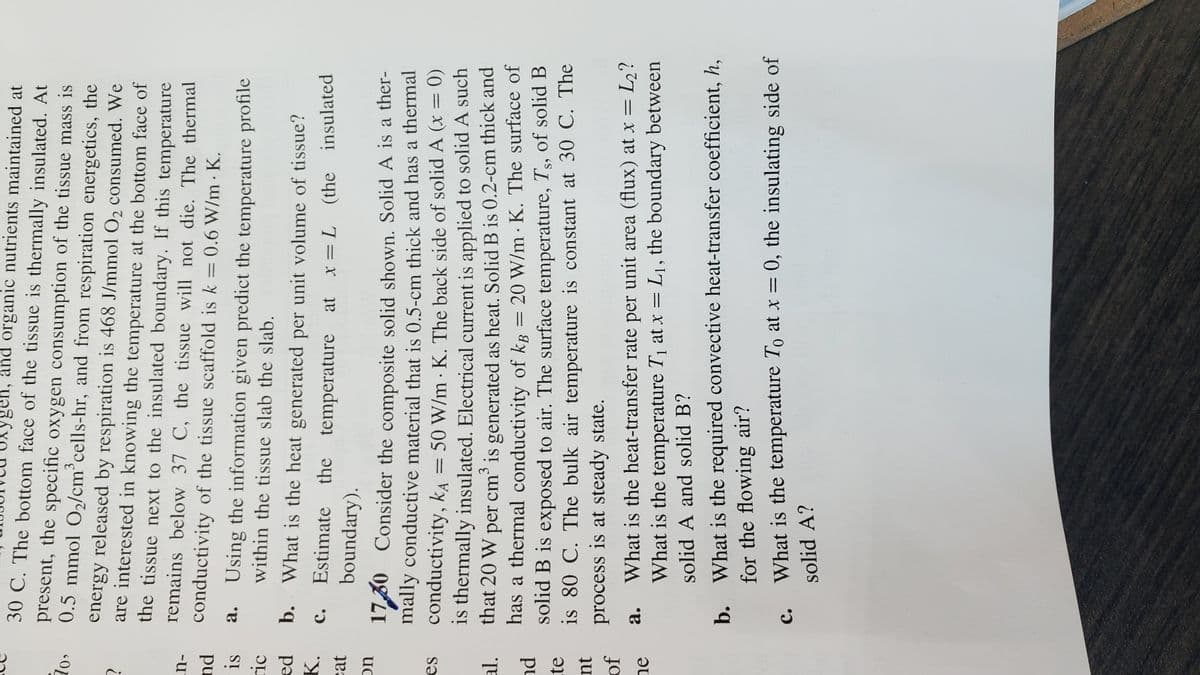. sider the composite solid shown. Solid A is a ther mally conductive material that is 0.5-cm thick and has a thermal conductivity, KA = 50 W/m K. The back side of solid A (x = 0) is thermally insulated. Electrical current is applied to solid A such that 20 W per cm³ is generated as heat. Solid B is 0.2-cm thick and has a thermal conductivity of kB = 20 W/m K. The surface of solid B is exposed to air. The surface temperature, Ts, of solid B is 80 C. The bulk air temperature is constant at 30 C. The process is at steady state. . a. What is the heat-transfer rate per unit area (flux) at x = L₂? What is the temperature T₁ at x = L₁, the boundary between solid A and solid B? b. What is the required convective heat-transfer coefficient, h, for the flowing air? C. What is the temperature To at x = 0, the insulating side of solid A?
. sider the composite solid shown. Solid A is a ther mally conductive material that is 0.5-cm thick and has a thermal conductivity, KA = 50 W/m K. The back side of solid A (x = 0) is thermally insulated. Electrical current is applied to solid A such that 20 W per cm³ is generated as heat. Solid B is 0.2-cm thick and has a thermal conductivity of kB = 20 W/m K. The surface of solid B is exposed to air. The surface temperature, Ts, of solid B is 80 C. The bulk air temperature is constant at 30 C. The process is at steady state. . a. What is the heat-transfer rate per unit area (flux) at x = L₂? What is the temperature T₁ at x = L₁, the boundary between solid A and solid B? b. What is the required convective heat-transfer coefficient, h, for the flowing air? C. What is the temperature To at x = 0, the insulating side of solid A?
Introduction to Chemical Engineering Thermodynamics
8th Edition
ISBN:9781259696527
Author:J.M. Smith Termodinamica en ingenieria quimica, Hendrick C Van Ness, Michael Abbott, Mark Swihart
Publisher:J.M. Smith Termodinamica en ingenieria quimica, Hendrick C Van Ness, Michael Abbott, Mark Swihart
Chapter1: Introduction
Section: Chapter Questions
Problem 1.1P
Related questions
Question
please show all steps Q17.30

Transcribed Image Text:10,
n-
nd
is
ric
ed
K.
cat
On
es
al.
nd
te
nt
of
ne
gen, and organic nutrients maintained at
30 C. The bottom face of the tissue is thermally insulated. At
present, the specific oxygen consumption of the tissue mass is
0.5 mmol O₂/cm³ cells-hr, and from respiration energetics, the
energy released by respiration is 468 J/mmol O₂ consumed. We
are interested in knowing the temperature at the bottom face of
the tissue next to the insulated boundary. If this temperature
remains below 37 C, the tissue will not die. The thermal
conductivity of the tissue scaffold is k = 0.6 W/m.K.
a.
b.
c.
a.
Using the information given predict the temperature profile
within the tissue slab the slab.
1730 Consider the composite solid shown. Solid A is a ther-
mally conductive material that is 0.5-cm thick and has a thermal
conductivity, kA = 50 W/m K. The back side of solid A (x = 0)
is thermally insulated. Electrical current is applied to solid A such
that 20 W per cm³ is generated as heat. Solid B is 0.2-cm thick and
has a thermal conductivity of kg = 20 W/m K. The surface of
solid B is exposed to air. The surface temperature, Ts, of solid B
is 80 C. The bulk air temperature is constant at 30 C. The
process is at steady state.
What is the heat generated per unit volume of tissue?
Estimate the temperature at x = L (the insulated
boundary).
C.
What is the heat-transfer rate per unit area (flux) at x = L₂?
What is the temperature T₁ at x = L₁, the boundary between
solid A and solid B?
b. What is the required convective heat-transfer coefficient, h,
for the flowing air?
What is the temperature To at x = 0, the insulating side of
solid A?
Expert Solution
This question has been solved!
Explore an expertly crafted, step-by-step solution for a thorough understanding of key concepts.
This is a popular solution!
Trending now
This is a popular solution!
Step by step
Solved in 6 steps

Recommended textbooks for you

Introduction to Chemical Engineering Thermodynami…
Chemical Engineering
ISBN:
9781259696527
Author:
J.M. Smith Termodinamica en ingenieria quimica, Hendrick C Van Ness, Michael Abbott, Mark Swihart
Publisher:
McGraw-Hill Education

Elementary Principles of Chemical Processes, Bind…
Chemical Engineering
ISBN:
9781118431221
Author:
Richard M. Felder, Ronald W. Rousseau, Lisa G. Bullard
Publisher:
WILEY

Elements of Chemical Reaction Engineering (5th Ed…
Chemical Engineering
ISBN:
9780133887518
Author:
H. Scott Fogler
Publisher:
Prentice Hall

Introduction to Chemical Engineering Thermodynami…
Chemical Engineering
ISBN:
9781259696527
Author:
J.M. Smith Termodinamica en ingenieria quimica, Hendrick C Van Ness, Michael Abbott, Mark Swihart
Publisher:
McGraw-Hill Education

Elementary Principles of Chemical Processes, Bind…
Chemical Engineering
ISBN:
9781118431221
Author:
Richard M. Felder, Ronald W. Rousseau, Lisa G. Bullard
Publisher:
WILEY

Elements of Chemical Reaction Engineering (5th Ed…
Chemical Engineering
ISBN:
9780133887518
Author:
H. Scott Fogler
Publisher:
Prentice Hall


Industrial Plastics: Theory and Applications
Chemical Engineering
ISBN:
9781285061238
Author:
Lokensgard, Erik
Publisher:
Delmar Cengage Learning

Unit Operations of Chemical Engineering
Chemical Engineering
ISBN:
9780072848236
Author:
Warren McCabe, Julian C. Smith, Peter Harriott
Publisher:
McGraw-Hill Companies, The